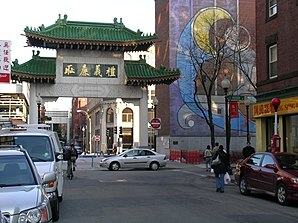Chinatown (Boston)
| Chinatown | |
|---|---|
 View of the Pailou in Chinatown |
|
| Borough of Boston | |
| Basic data | |
| State : | United States |
| State : | Massachusetts |
| County : | Suffolk |
| Coordinates : | 42 ° 21 ′ N , 71 ° 4 ′ W |
| Time zone : | Eastern ( UTC − 5 / −4 ) |
| Residents : | 6,015 (as of: 2000) |
| Population density : | 10,936.4 inhabitants per km 2 |
| Area : | 0.55 km 2 (approx. 0 mi 2 ) |
| Postal code : | 02111 |
| Area code : | +1 617, 857 |
| GNIS ID : | 606756 |
The neighborhood ( eng. Neighborhood ) Chinatown ( Chinese 波士頓 唐人街 / 波士顿 唐人街 , alternatively 波士頓 華埠 / 波士顿 华埠 ) is located in downtown Boston in the state of Massachusetts in the United States and is the only historical Chinese area in New England .
geography
The signature entrance gate to Chinatown (a pailou with a guardian lion on either side) is at the intersection of Beach Street and Surface Road . As part of the Big Dig project, a park was created at this point . The gate is clearly visible from the bus station at Boston South Station and is a popular attraction with tourists.
Expansion of the urban area
The district is arranged along Beach Street and is bounded by Boston Common , the Downtown Crossing and South End districts, and Interstate 93 .
City structure
More recently, about 10 mi (16.09 km ) south of the borough, a satellite town of the same name has established itself on Hancock Street in neighboring Quincy . The new district is mainly of Hokkien -speaking Chinese immigrants from the province of Fujian , as well as in exile living Vietnamese inhabited. There are already some major Asian markets and other stores that compete with the original Chinatown . As a result, many Chinatown stores have opened branches in Quincy .
history
Population development
Part of Chinatown is on land that was reclaimed from landfill and initially settled by white Anglo-Saxon Protestants . After the properties in this area increasingly lost value due to the advancing railway development, immigrants consisting of Irish , Jews , Italians , Syrians and Chinese moved to the area. They took advantage of the fallen house prices and good job opportunities in the district. During the late 19th century, textile factories also moved into the neighborhood, forming what is now the historic Garment District , which was still in operation until the 1990s.
In 2000, 6,015 people lived in the district, which, with a population density of 28,136 people per square mile, is more than twice as densely populated as Boston itself. 69% of the population are Asians, followed by whites (17%), blacks (7%) and Hispanics (5%). The median household income was 14,829 US dollars , the average age of 35.1 years. 60% of the population do not have a high school diploma.
Culture and sights
Buildings
The Hayden Building is a historic building located at 681-683 Washington Street and was designed by Henry Hobson Richardson in 1875 . In 1980 it was added to the National Register of Historic Places .
Culinary specialties
Chinatown is still the center of Asiatic-American life in New England and is home to many Chinese and Vietnamese restaurants and markets .
Economy and Infrastructure
traffic
There are several local and regional transportation links in Chinatown . The district is on the Red Line and Silver Line of the MBTA approached, as commuter trains on the can Boston South Station and the Orange Line at the station Chinatown are used. The Interstate 93 and the Massachusetts Turnpike are also located nearby. The two bus routes Fung Wah and Lucky Star / Travelpack have hourly connections to Chinatown in New York City .
media
The The World Journal - Boston Edition is the largest and most widely read newspaper in the district. The non-profit newspaper Sampan appears twice a month in English.
Public facilities
The Tufts Medical Center occupies a large part of the area of the district. It has a hospital and a variety of Tufts University healthcare educational institutions , including Tufts University School of Medicine , Sackler School of Graduate Biomedical Sciences , Gerald J. and Dorothy R. Friedman School of Nutrition Science and Policy, and Tufts University School of Dental Medicine .
Founded in 1972 to better care for Asian Americans , the South Cove Community Health Center operates the Chinatown Clinic on Washington Avenue .
Picture gallery
Impressions from the Chinese New Year celebrations in the district from 2009:
literature
- Stacey GH Yap: Gather your strength, sisters . the emerging role of Chinese women community workers. AMS Press, New York 1989, ISBN 978-0-404-19434-5 .
Web links
- Works by and about City of Boston and Grub Street, Inc. at Open Library
- The Chinatown Park
- Boston Chinatown Neighborhood Center website
- Asian American Civic Association website
- Asian Community Development Corporation website
Individual evidence
- ^ Sue Kim, Gregory W. Perkins: Chinatown Profile. (PDF; 871 kB) Census 2000. (No longer available online.) Boston Redevelopment Authority, September 19, 2003, archived from the original on October 5, 2011 ; accessed on March 27, 2012 (English). Info: The archive link was inserted automatically and has not yet been checked. Please check the original and archive link according to the instructions and then remove this notice.
- ^ World Journal Boston edition. Retrieved March 28, 2012 (English).
- ^ The Sampan Newspaper. Retrieved March 28, 2012 (English).
- ^ South Cove Community Health Center. Retrieved March 28, 2012 (English).






